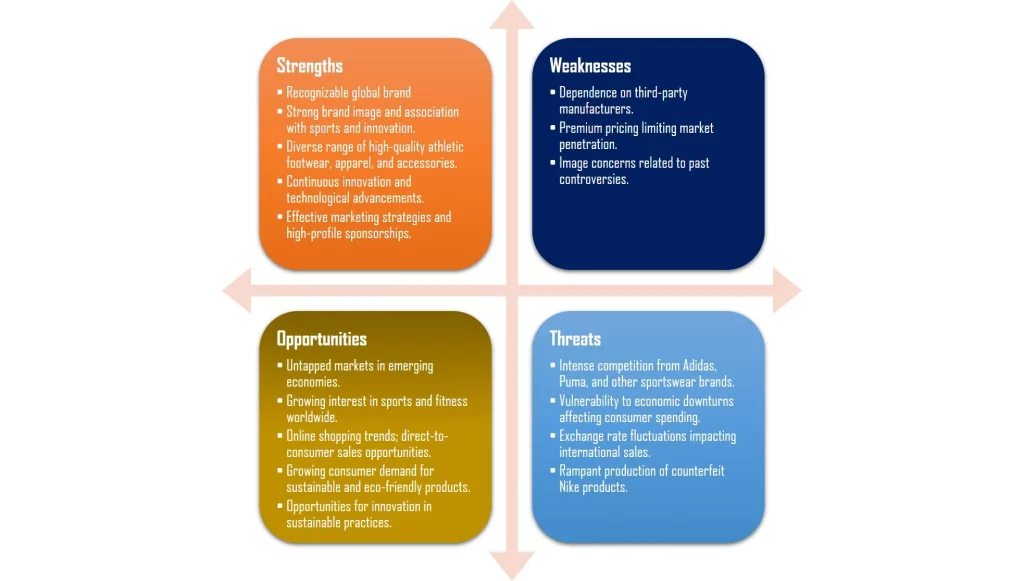
Below is a sample SWOT analysis essay on Nike, Inc. This example is intended to help students write better business analysis essays.
Nike Inc. SWOT Analysis Essay
SWOT Analysis Essay Outline: Nike
- Introduction: Brief overview of Nike and its position in the market.
- Company: Nike, Inc.
- Date of Establishment: January 25, 1964 as Blue Ribbon Sports
- Founders: Bill Bowerman and Phil Knight
- Products: Sporting Goods and Accessories: shoes, apparel, equipment
- Current CEO: John Donahoe (2013 – present)
- Headquarters: Beaverton, Oregon, United States.
- No. of Employees: 83,700
- Type: Public
- Ticker Symbol: NKE (NYSE)
- Revenue: US$51.22 billion (2023)
- Net Income: US$5.07 billion (2023)
- Competitors: Adidas, Puma, New Balance, Reebok, Under Armour, Fila, Kappa, Skechers.
- Strengths:
- Brand Strengths
- Recognizable global brand. In 2020, the brand alone was valued in excess of $32 billion, making it the most valuable brand among sports businesses.
- Strong brand image and association with sports and innovation.
- Product Portfolio
- Diverse range of high-quality athletic footwear, apparel, and accessories.
- Continuous innovation and technological advancements.
- Marketing and Sponsorship
- Effective marketing strategies.
- High-profile sponsorships with athletes and sports teams.
- Weaknesses:
- Dependence on Third-Party Manufacturers
- Heavy reliance on contract manufacturers.
- Vulnerability to supply chain disruptions.
- High Prices
- Premium pricing may limit market penetration.
- Potential impact on price-sensitive markets.
- Image Concerns
- Past controversies related to labor practices.
- Environmental concerns in manufacturing processes.
- Opportunities:
- Global Expansion
- Untapped markets in emerging economies.
- Growing interest in sports and fitness worldwide.
- E-Commerce Growth
- Increasing online shopping trends.
- Opportunities for direct-to-consumer sales.
- Sustainability Trends
- Growing consumer demand for sustainable and eco-friendly products.
- Opportunities for innovation in sustainable practices.
- Threats:
- Intense Competition
- Strong competition from Adidas, Puma, and other sportswear brands.
- Constant pressure to stay ahead in innovation.
- Economic Fluctuations
- Vulnerability to economic downturns affecting consumer spending.
- Exchange rate fluctuations impacting international sales.
- Counterfeit Products
- Rampant production of counterfeit Nike products.
- Potential damage to brand reputation.
- Analysis and Strategy Development:
- Evaluate the intersections of strengths, weaknesses, opportunities, and threats.
- Develop strategies that leverage strengths, address weaknesses, capitalize on opportunities, and mitigate threats.
- Conclusion: Summarize key findings and outline strategic priorities based on the SWOT analysis.
This outline and sample essay provides a structured approach to conducting a SWOT analysis for Nike, considering its internal and external factors to inform strategic decision-making.

